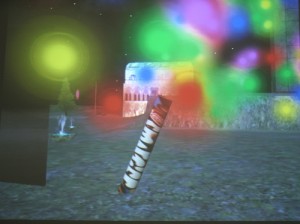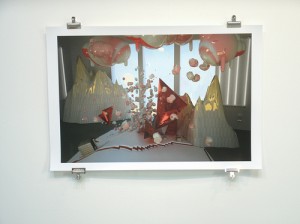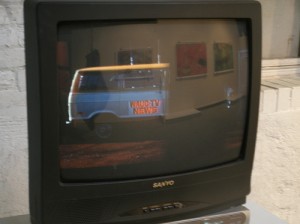Eteam’s “Prim Limit,” one of the pieces in the “Landscape Techne” exhibition at Little Berlin through November 27th, is a half-hour film that takes place in the “Second Life” virtual world, an online computer game that allows users to design their own avatar world.

At first, the idea of watching a low-tech, virtual world for half an hour seemed impossible, but it turned out to be a thought-provoking and meditative experience. Most of the sound does not exist in the “Second Life” world; instead, the film uses the voice of the narrator, an avatar who is a tough older man with a German accent, with calm music playing in the background. This human voice plays a vital role in helping the viewer to empathize with these imaginary characters and fake landscapes that have real humans operating them. The story is the narrator’s experience in the avatar world as he watches his area of land as well as the characters and objects in and around it.
The film points out how easy it is to build, demolish and rebuild in the avatar world through its focus on a “dumpster,” which breaks down the objects and characters inside it. In “Second Life,” users are given a limited amount of space depending on the time and money they invest. Instead of buying more land, Eteam made a computer script to create the “dumpster”. In “Prim Limit”, appearances of people and objects change within seconds. Seeing things decay is unusual in a virtual world, and in the film viewers are faced with difficult images. Displayed decay rates — numbers superimposed on objects in the film — evoke sadness, an appreciation for seeing something that will soon disappear, and calmness because the end result is known. But there is also a sense of relief that comes from the deliberately unrealistic, low-tech imagery, which reminds the viewer that what they are watching is not real. In these online avatar worlds, it is the interaction with other players that makes the world seem realistic, not the imagery. Loneliness pervades this film about a fictional world real people use as a way to interact with others, while in reality they remain solitary figures behind their computers.
Alex McLeod’s CGI prints are of imagined landscapes and interiors. These whimsical images are so sugary and slick it’s frightening. They are human-less, post-cataclysmic scenes covered up by candy surfaces. The work splits viewers into two opposing groups – the ones who love the candy surfaces, and the ones who hate it. When I first saw these prints I was attracted by the color relationships and the complicated but clear spatial organization. Then on closer inspection I felt uneasy with the images – they are so pretty and filled with kitschy objects, yet the images are trying to convince viewers that these fantastic worlds are real. Is he trying to imitate Jeff Koons’ polished surfaces? Is he giving in to just making pretty work with no genuine investment, thought, or human quality? The most successful prints are the ones that really try to convince the viewer into thinking they are real spaces and landscapes. They put the viewer in a situation where he/she has to grapple with how alternate realities can affect real lives, how much time should be spent on these escapes, and with the fact that these alternate worlds do not have the power to relieve us from our daily responsibilities. Visions of Star Wars conventions, Renaissance fairs, and Disney World come to mind.

Another intelligent and humorous approach to landscape in this show is a video called “Philly Scenes (Rocky)” by Maria Dumlao. According to Little Berlin member Kristen Taylor, Maria Dumlao wanted to create a video in the same spirit as the “Rocky” movies, but to remove the character of Rocky and give the landscape the role of the protagonist. It was challenging to hear the video with so many other videos going on in this exhibition, but even without completely hearing the staged 1970s Philly street scenes, the artist’s use of the cityscape is able to evoke emotions just as well as the character of Rocky. It also allows for a more open-ended narrative. The viewer is engaged and challenged more without knowing exactly what is happening. Humans play an important role in the video – but it is the series of street scenes as a whole that is the focus.

As a whole, “Landscape Techne” explores the ways in which technology and current social change have influenced landscape as subject matter. The exhibition also has works by Carl Diehl, Rafael Rozendaal, Xarene Eskandar, and Luke Painter. In many ways, “Landscape Techne” questions initial gut reactions. The conceptual framework of this exhibition reminded me of Art & Language, the 60s-era conceptual art movement based in England and briefly in America. Like Art & Language, this exhibition acknowledges the importance of analyzing and reflecting on the practice of making art. It questions why artists still use landscape today and searches for ways in which it can be done effectively in the context of contemporary art.
Post by Kathleen Vaccaro.









